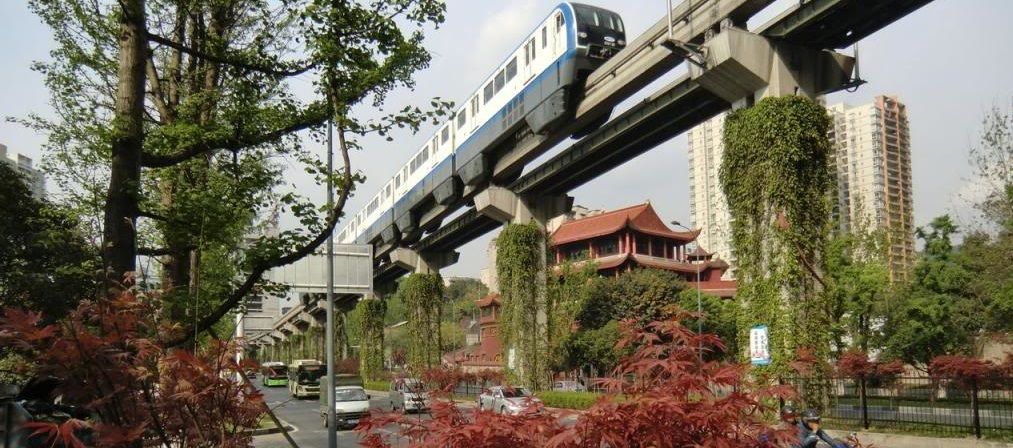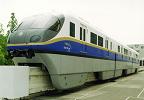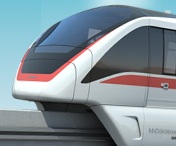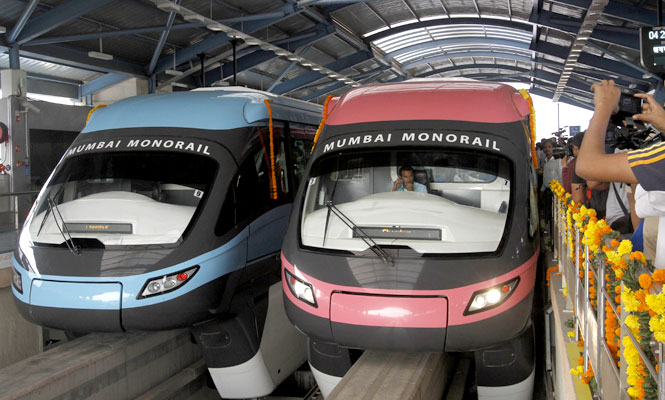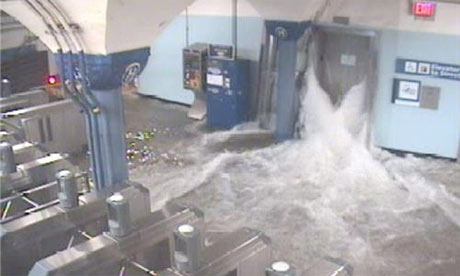As images on this page show monorail pillars can be part of a pleasant urban landscape. We believe this can be further improved by using sandstone coloured concrete and covering the pillars with climbing plants.
Good Design Examples
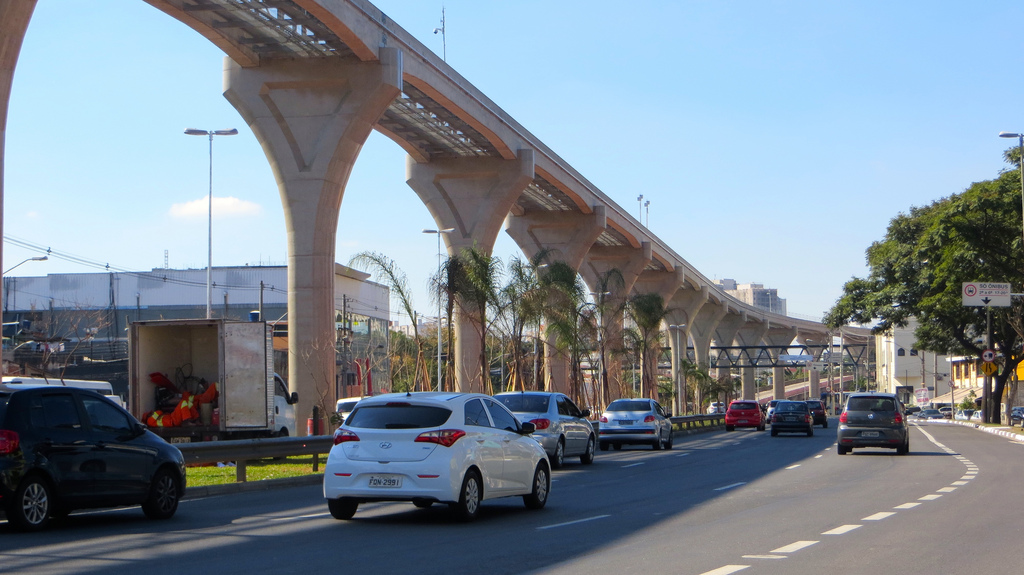
New monorail track for São Paulo, Brazil. (Original Image: www.skyscrapercity.com) |
The new São Paulo monorail has a very good pillar design and further landscaping is planned.
The monorail in Naha, Okinawa now has considerable landscaping as can be seen in google street view, although the original pillar design is not as good as in São Paulo.
For the most part Japanese monorails make few concessions to aesthetics, but as shown below some parts of the Tokyo Haneda monorail are pleasant enough. For example see Monorail Society - Tokyo Trees page featuring a well landscaped section of the Tokyo- Haneda monorail.
|
Google street view
Street view of Kitakyushu Monorail, Japan. |
Track design for Australian monorails
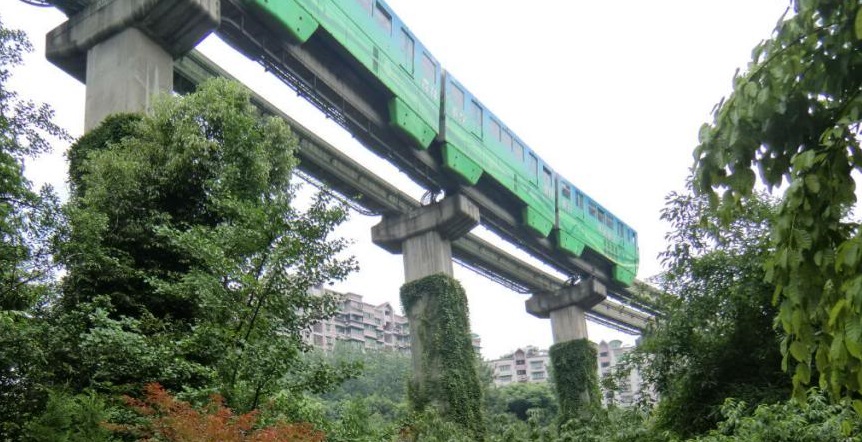
Another part of the 75 km Chongqing Monorail by Hitachi (Skyscraper City) |
- Coloured Concrete: The concrete used for the track, pillars and stations would be sandstone-coloured to avoid the drab grey of standard concrete construction.
- Double Track: In all cases double track is recommended. As with any rail system having a single track places severe limitations on service frequency. The savings from having a single track are limited and space is unlikely to be an issue. It is possible that in some case the left and right tracks could be routed on either side of some obstacle for a short distance. In the CBD it may be useful to have a split station hosted on buildings on opposite sides of the street.
- 25 meter column spacing. In general the maximum spacing for column supporting concrete beams would be used which is about 25 meters. Greater spans can be obtained by using steel beams or concrete beams supported by steel.
- Pillars: The pillars are about 1.2 meters in diameter and can have a high quality finish. Pillars will be sized to ensure at least 4.3 meter clearance
over all major roadways. We recommend all support columns and stations are installed with extensive
vegetation covering most of the vertical surfaces to create
living walls.
This is both to improve aesthetics of the pillars and to discourage
vandalism.

The climbing fig Ficus pumila (Wikipedia) - Tree Way: As shown in the above examples a "tree way" can be created underneath the monorail track. Where trees are already present as many as possible will be retained and additional plantings created.
Mitsubishi suspended monorails
The two current Mitsubishi monorails have an aesthetically-challenged guide-way but covering the guide-way with a simple facia and choosing a colour other than grey improves the situation markedly as shown below.
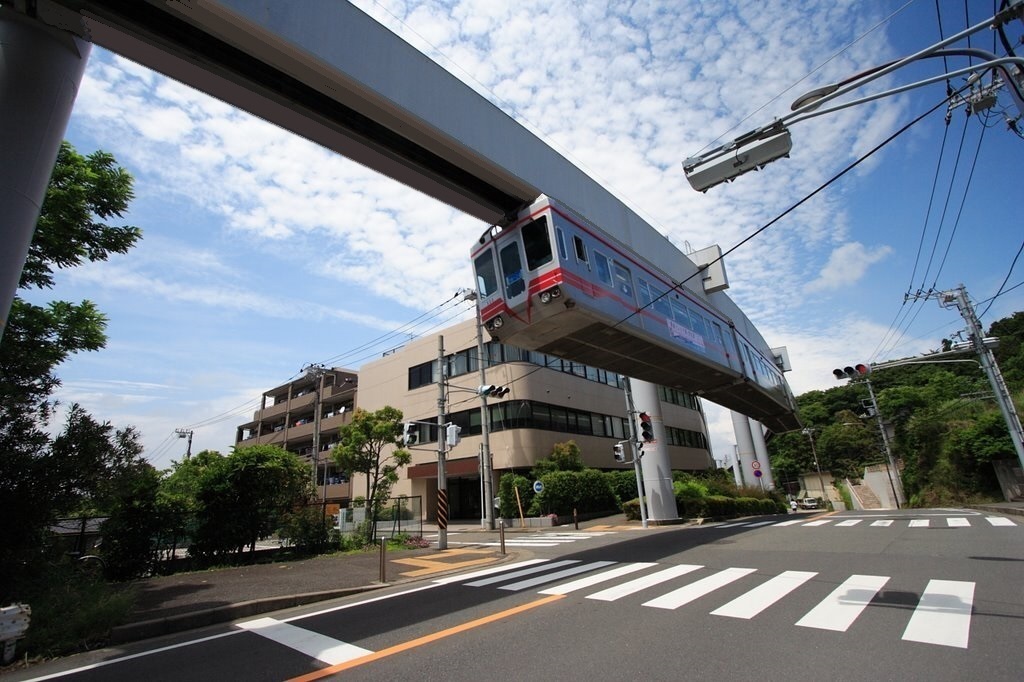
An adjusted image of the Shonan Monorail. In this image the guide-way has been covered at the base to improve the appearance (original image <-> adjusted image. Original image from www.panoramio.com). |
Monorail guide way standards
Australia's rail system has been adversely impacted by the adoption of various rail gauges across the continent. A similar mistake can be made with straddle beam Monorails.
The objective is to have a standard monorail guide way adopted for all Monorails.
In selecting particular technologies and providers:
- A single guide way type for Urban Transit Monorails should be selected for each City if not the whole country.
- At the point of selection the selected manufacturer would have to agree to reasonable licence fees for their technology to be used going forward if they wish their technology to be the standard for the State if not Australia.
- The selected manufacturer would also need to agree for others to manufacturer monorail vehicles or guide way of the agreed guide way standard should the selected manufacturer cease to exist.
Safety
Many safety features are built into modern transit monorail systems making them safer than most other transit systems.
- A second or third monorail train could be used to evacuate passengers from a stranded or damaged monorail train, although
in practice this has never been necessary. (Note that evacuation via the front of the monorail is only feasible with Hitachi
designs as they have doors at the front and rear.)
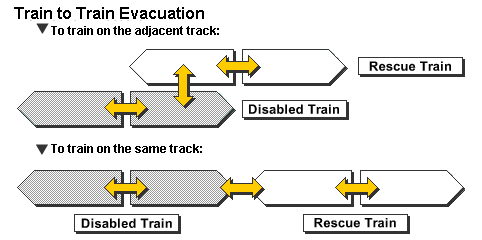
- All the recommended monorail designs allow passage between carriages for all passengers including those in a wheel chair. We recommend fire-resistant doors be fitted to trains to allow some partitioning of the train. We also recommend large CO2 extinguishers be carried on the trains.
- Elevated rail systems are inherently safer than subway systems due to the speed at which most elevated trains can be reached from the ground compared to stranded subway vehicles deep in the ground.
- Passengers on a burning elevated monorail train are less likely to be overcome with smoke and fumes than passengers on a burning subway car, especially if internal fire doors were fitted to the monorail.
- Where monorail pylons are located on or near road or rail lines they should be built to withstand substantial impacts without collapse.
- Monorail beams will not cross roads with a height clearance less than other existing infrastructure or the maximum height allowable for trucks.
- The monorail should draw power at multiple points and have regular back-up generators capable of at least moving the monorail carriages to the next station.
Costs and Benefits of Walkways
Any monorail can have an emergency walkway as shown in the below image. However, most large Hitachi systems do not have walkways instead relying on train-train evacuation and emergency slides for evacuation. This has proved adequate for decades.
Emergency walkways could prove to be a mixed blessing as they would attract unauthorised usage by vandals and others. Evacuating passengers from a train to the walkway would only be useful in a limited number of unlikely circumstances. At this stage we would recommend against emergency walkways as they could cause more problems than they solve.
|
Bombardier track can include a walkway along the entire length of the monorail guideway. (vimeo.com/65368766) |
If no walkway is used it is likely that the guideways can be closer together which would make train-to-train evacuation easier.
Safety compared to subways
Emergencies in subways are challenging due to limited access. Fire and flood are always a possibility and underground fires are quite lethal due to the rapid build-up of toxic smoke.
|
Moscow subway derailment July 2014 kills nineteen and wounding 120 other passengers (Al Jaazeera) |
By contrast multiple emergency services units can gain rapid access to elevated transit systems with standard fire-fighting equipment.
Disabled access
Like any modern subway system, monorail systems are accessed by lift from street level. As lift floor, platform floor and monorail car floors are at the same level there is no impediment to the disabled person using the Monorail. The three meter wide flat floors of the high capacity monorails shown on these pages offer improved disabled access compared to most buses and trams.
Minimal advertising
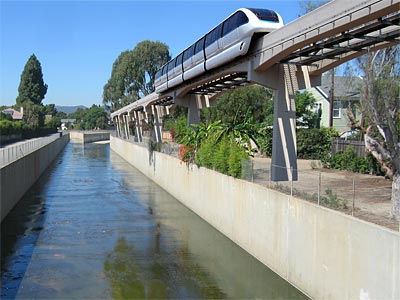
Artists impression of an LA monorail running over the flood channels. (http://lavisions.blogspot.com.au) |
It is suggested that Monorail trains, stations and pillars carry minimal advertising.
This needs to be written in to key contract documents to prevent future operators covering monorail infrastructure with unsightly billboards which would degrade the aesthetics of the system. This would still leave open the possibility of selling naming rights on each train which would allow the name and logo of the sponsoring company appearing on the train.
Under the track
Wherever possible a 'tree way' will be planted underneath the monorail track. Along many suggested routes trees are already in place, in this case every effort would be made to retain as many trees as possible.
|
Visit Okinawa monorail Street View of Naha Monorail, Okinawa. We aim to have more aesthetic pillars in place for Australian monorails. (If Street View does not display then click here and click street view.) |
The Kitakyushu monorail has sections with a 'tree-way' under the guide way. We would add creepers to the support pillars.
|
Visit Kitakyushu monorail. See also here. |
Long spans
Hitachi used braced steel girders to support the track through over long sections without pillars and for tight curves track for it's Okinawa Monorail.
|
View Larger Map Street View of Naha Monorail, Okinawa showing a long curved span. (If Street View does not display then click here and click street view.) |
Long spans - Cable Stayed?
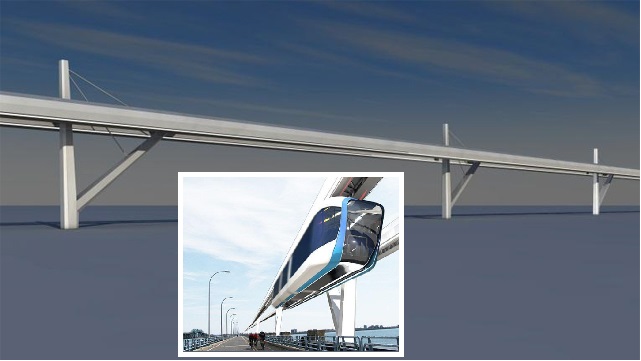
Design concept for the "UbiCiT" cable-stayed suspended monorail track in Montreal. (UbiCiT) |
This design for a suspended monorail track uses a cable-stayed design to extend the spans between pylons.
(This design work was done by the Polytechnique Montréal, HEC Montréal and the Université de Montréal’s School of Industrial Design between 2011 and 2012 which aimed to create an all-weather transit system for the area.)
Offset guide way support
Offset track can be used where a central pillar is impractical further increasing design flexibility.
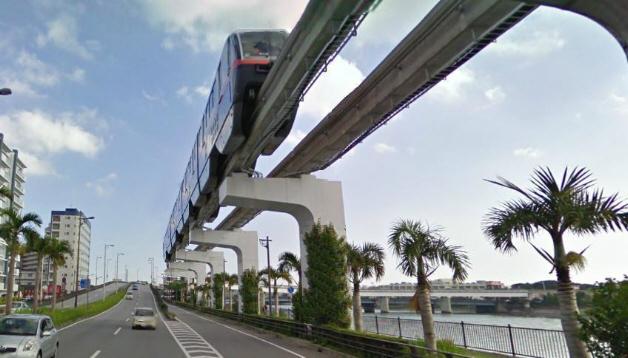
Okinawa monorail section with offset pillars. (Image adjusted to show a four car train - currently this monorail uses two-car trains.) |
Stations
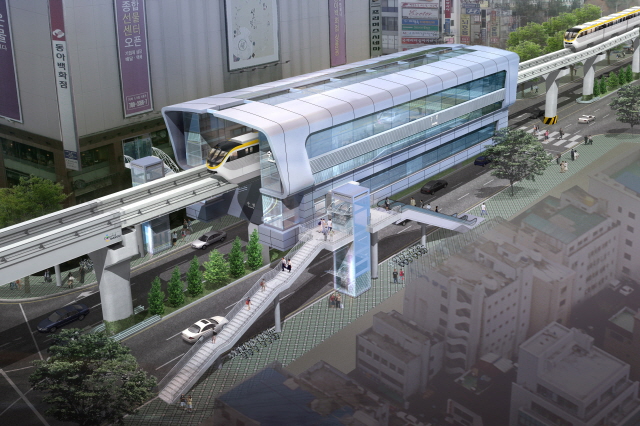
Art rendering of a proposed new monorail station for Daegu, South Korea. Note the very low footprint of the station above the road. We recommend longer stations to cater for eight-carriage trains. (Daegu Blog) |
We recommend stations have the tracks in the centre and the platforms on the edge. This means the track components are the same as those used elsewhere on the system. As far as possible the stations themselves should all be of the same design to allow mass producion in modular form to cut costs.
Stations should be built to allow the maximum length of train which would be 8 carriages, not the three carriage trains shown above. Station size could be reduced slightly by not having doors on the first and last carriages.
All stations should have:
- Highly energy-efficient design to minimise heating and cooling requirements.
- Floor to ceiling platform screen doors.
- Evaporative air-conditioning.
- Solar panels on the roof to assist with the air conditioning and lighting.
- Multiple elevators, escalators and stairs.
- Living walls where possible.
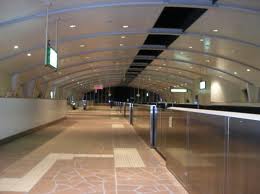
Maihama station, Tokyo (Image: Wikipedia)
Monorail videos
A stylish new monorail
This video shows how a Bombardier monorail could be rolled out over congested roads to provide new public transport.
|
A June 2011 Bombardier presentation to the City of Rio de Janeiro for an integrated transit project in Barra da Tijuca featuring a monorail that would be ready for the 2016 Olympic games. |
